DinoFest 2024: Damage & Defense
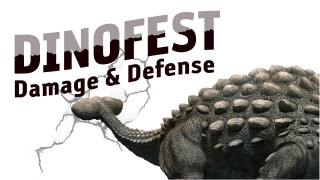
©NHMU
Have you ever wondered how dinosaurs used their spikes, horns, and armor? Whether dinosaurs could heal from injuries and infections? At NHMU's eighth-annual DinoFest held on January 27-28, 2024, we explored these very questions and more with a theme of dinosaur Damage & Defense.
A lineup of world-class paleontologists joined us to present evidence for dinosaur defensive structures, and the injuries they received from predators, fighting each other, and disease. Our guests shared in-person keynotes and DinoBite talks and met with guests to offer an insider look at the latest and most groundbreaking discoveries.
DinoFest guests also enjoyed special access to the Paleo Prep Lab and Paleontology Collections to get up close with incredible fossils. And, community partners filled the Museum's Canyon to highlight the region's many dinosaur research and educational communities.
Guest Speakers
Check out our lineup of incredible guest speakers who helped us explore dinosaur Damage & Defense.
DinoFest Keynote: Dr. David Evans
Saturday, January 27, 12:00 - 12:55 p.m.
Zuul: Armored Dinosaur Fight Club
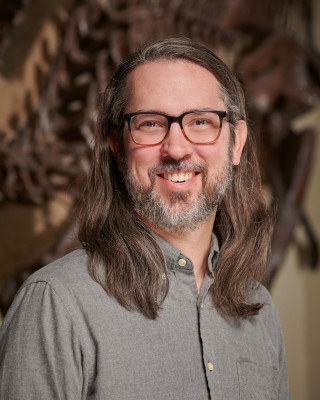
Ankylosaurid dinosaurs are heavily armoured animals with iconic tail clubs that are among the most wicked weapons ever to evolve. For decades, these dinosaurs were depicted as using these club to defend themselves from predatory tyrannosaurs, but surprising new discoveries turns this idea on its tail. The exceptionally preserved skeleton of Zuul crurivastator provides new evidence for how armored dinosaurs used their clubs; it has armor spikes along its flanks that were broken and re-healed while the dinosaur was alive – injuries most likely caused from a strike by another Zuul’s massive tail club--revolutionizing our view of these dinosaurs from slow solo defenders, to socially-complex jousters. Read more about David's research on Zuul in this blog post.
About the Speaker
Dr. David Evans oversees dinosaur research at the Royal Ontario Museum (ROM) and University of Toronto. He is recognized an expert on the end of the Age of Dinosaurs, and has amassed over 125 scientific publications to date. Dr. Evans curated the blockbuster traveling exhibition Ultimate Dinosaurs, and was the Co-creator of the hit HISTORY TV series Dino Hunt. Active in the field, he has participated in expeditions all over the world, and has helped discover 15 new dinosaur species in the last decade--including the remarkable horned dinosaur Wendiceratops from Alberta, and the wickedly armored Zuul named after the Ghostbusters movie monster.
DinoFest Keynote: Dr. Susannah Maidment
Sunday, January 28, 12:00 - 12:55 p.m.
The Stegosaurus

Stegosaurs are one of the most iconic dinosaurs, and are characterized by the possession of two rows of plates and spikes that extended from their necks to the end of their tails. Stegosaurs had a global distribution, and they reached their highest diversity in the Late Jurassic. The function of their enigmatic armor is difficult to establish, but it was probably used for a combination of display and thermoregulation.Read more about Susannah's research on stegosaurs in this blog post.
About the Speaker
Dr. Susannah Maidment is a dinosaur researcher at the Natural History Museum, London, UK. She studies the origin and establishment of dinosaur-dominated ecosystems, and has a particular interest in the stegosaurian dinosaurs. Dr. Maidment was one of National Geographic UK’s Women of Impact in 2019. In 2016, she was awarded the Geological Society of London’s Lyell Fund and in 2017 the Paleontological Association’s Hodson Award, both for notable contributions to paleontology. She has a PhD in vertebrate paleontology from the University of Cambridge.
DinoBite Speaker: Dr. Jim Kirkland
Saturday, January 27, 1:00 - 1:25 p.m.
Keeping Up with the "Raptors": The Evolution of Armor in Polacanthine Ankylosaurs
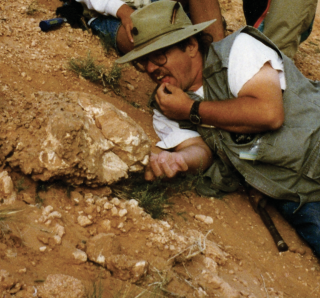
Late Jurassic, Morrison dino-fauna, Utah preserved a lower diversity dino-fauna dominated by allosauroids, therizinosaurs, ornithomimids, and dromaeosaurs (“raptors”) with two sauropod dinosaur lineages, iguanodonts, and polacanthine ankylosaurs. The “raptors” diversified and got larger, while the armored polacanthines got progressively spinier and more armored resulting in the spiniest dinosaurs known, prior the mid-Early Cretaceous extinction event.
About the Speaker
Dr. Jim Kirkland has been the State Paleontologist for 23 years. An expert on the Mesozoic, with 50 years excavating fossils across the southwest and Mexico, authoring and coauthoring 90+ papers. Biostratigraphy, paleobiogeography, paleoecology, and mass extinctions are interests. He is fond of ankylosaurs, describing 23 dinosaurs, many other taxa, and several stratigraphic units. His research in eastern Utah documented the most complete, fossiliferous Early Cretaceous record in the world.
DinoBite Speaker: Dr. Megan Whitney
Saturday, January 27, 1:30 - 1:55 p.m.
Investigations into Fossil Damage and Disease Under the Microscope
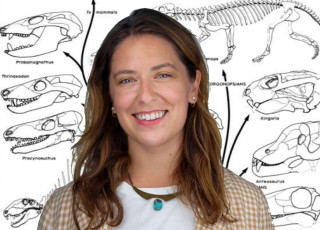
From the great and mighty to the small and tiny, the study of disease and damage under the microscope can provide unparalleled insights fossil animals. Here we will explore how scientists use microscopic details of trauma and disease to better understand the behaviors and lives of animals that lived hundreds of millions of years ago.
About the Speaker
Dr. Megan Whitney is a paleontologist and professor of biology at Loyola University Chicago. Her work investigates big, macroevolutionary questions using tiny, microscopic details preserved in fossil bones and teeth. Her research in paleohistology takes her on field expeditions to places such as Zambia and Antarctica to find fossils that can help bring animals that have been dead for hundreds of millions of years, back to life.
DinoBite Speaker: Dr. Joseph Peterson
Saturday, January 27, 2:00 - 2:25 p.m.
Tyranno-Sores: Injuries and Behavior of a Teenage T. Rex
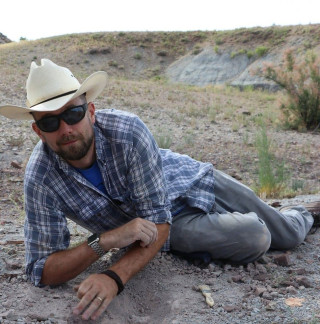
Think it was rough being a teenager? Try being a Teenage T. rex! While Tyrannosaurus rex is one of the most famous dinosaurs of all time, what do we know about the teenage years for the tyrant lizard? In this presentation on “Dino-Damage”, we investigate the fossil record for evidence and indicators of behavior in juvenile and subadult T. rex, including diet, ecology, and injuries.
About the Speaker
Dr. Joseph Peterson is a Professor of Geology at the University of Wisconsin Oshkosh. His research in vertebrate paleontology covers a wide range of subjects including injuries and behavioral interpretations in dinosaurs, the science of how fossils are preserved, and paleoecology. He has been actively working in the Morrison Formation of Utah for the last decade studying the accumulation of bonebeds in the Late Jurassic period.
DinoBite Speaker: Dr. Stephanie Drumheller
Saturday, January 27, 2:30 p.m. - 2:55 p.m.
What's Eating You? Using Bite Marks to Explore Diet and Behavior in the Fossil Record
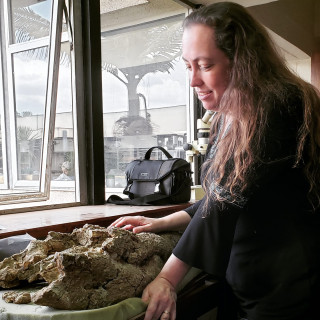
The path to becoming a fossil is rarely simple or straightforward, and all steps in that process can leave their marks on bones. Predators, scavengers, and sometimes just unruly neighbors play a role in that process, leaving behind bite marks for paleontologists to find. However, interpreting these traces of past behavior can present their own challenges. Studies of modern bite marks and site-wide surveys of marked, fossil bone are revealing interesting hints at dinosaurian behavior and diet in deep time.
About the Speaker
Dr. Stephanie Drumheller is a senior lecturer in the University of Tennessee Department of Earth and Planetary Sciences. Her research brings together ichnology (the study of behavioral traces) and taphonomy (the study of all the processes that move, modify, or destroy remains after death) to ask questions about diet, feeding strategy, behavior, and preservation in the fossil record.
DinoBite Speaker: Dr. Ali Nabavizadeh
Sunday, January 28, 1:00 - 1:25 p.m.
Functional Anatomy of the Feeding Apparatus and Defense in the Heads of Ornithischian Dinosaurs
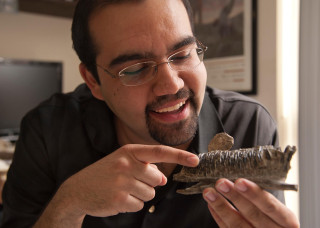
Ornithischians are a diverse group of herbivorous dinosaurs, many with elaborate cranial defense structures. Join me in exploring how the amazing anatomy of such forms as ceratopsians (with elaborate headgear in the form of horns and frills), ankylosaurs (with armored faces), hadrosaurs (many with elaborate headgear used in specialized communication), and others were able to balance self-defense with unique specializations in the skull, teeth, and musculature vital for eating the plant life of their time.
About the Speaker
Dr. Ali Nabavizadeh is a comparative anatomist, vertebrate paleontologist, and assistant professor of anatomy at the University of Pennsylvania School of Veterinary Medicine. His research explores the evolution of feeding adaptations and musculature in herbivorous dinosaurs as well the evolution of craniofacial musculature in other large herbivores, including elephants and dicynodonts.
DinoBite Speaker: Dr. Andrew Farke
Sunday, January 28, 1:30 -1:55 p.m.
Fighting Triceratops: What's the Evidence?
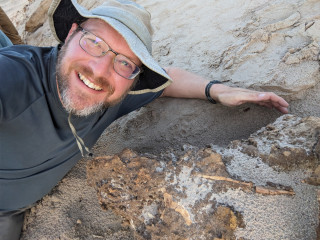
How did Triceratops use those horns? For over a hundred years, paleontologists have speculated about the odd headgear of horned dinosaurs. Without a working time machine to view these animals in the wild, we have to get creative! It starts by playing with plastic dinosaurs...and ends with searching fossil skulls for combat damage. Learn what we can--and can't--know in tracking dinosaur behavior!
About the Speaker
Dr. Andrew Farke is a paleontologist who studies the evolution of ecosystems in western North America during the end of the Age of Dinosaurs. He is an expert in the horned dinosaurs, or ceratopsians, has published on everything from duckbilled dinosaurs to turtles, and currently focuses on fieldwork in the Cretaceous of Wyoming. Dr. Farke is director at the Alf Museum, where he collaborates with high school students to reveal the mysteries of the past.
DinoBite Speaker: Dr. Mark Loewen
Sunday, January 28, 2:00 - 2:25 p.m.
Horns and Frills

In this presentation, we will discuss the amazing weird structures present on theropods and ceratopsians and what they may have been used for.
About the Speaker
Dr. Mark Loewen is a vertebrate paleontologist at the University of Utah who specializes in research on dinosaurs including Allosaurus, Tyrannosaurus, Stegosaurus, and Triceratops. Mark is a Professor at the University of Utah and teaches the popular World of Dinosaurs and Science in Cinema classes. He conducts research at the Natural History Museum of Utah where he is a Resident Research Associate.
Want More DinoFest?
If you've made it this far and are still craving more paleontology, then learn more about DinoFest here.
Or, check out our blog where you can find articles on paleontology and much more.